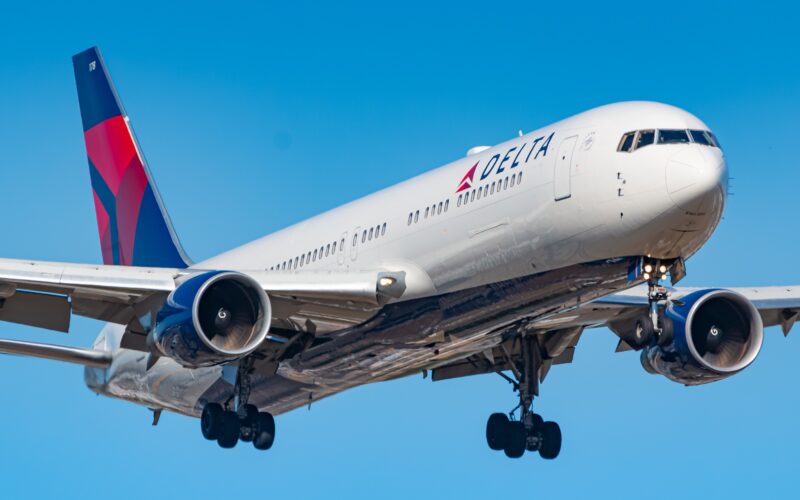The United States (US) National Transportation Safety Board (NTSB) published a final incident report detailing an incident on a Delta Air Lines flight from Czechia to the US where reduced aileron movement was caused by leaking lavatories.
Delta Air Lines flight DL211 from Václav Havel Prague Airport (PRG), Prague, Czechia, to John F Kennedy International Airport (JFK), New York, US, was operated by a Boeing 767-300ER, registered as N181DN. The flight departed PRG without problem on July 7, 2022.
However, during the flight a flight attendant informed the pilots that two mid-cabin lavatories were leaking water. There were two crews on the flight, both with a captain and a first officer. Following the flight attendant’s call, the reported noted that the non-flying crew confirmed that “one lavatory was leaking water from under the lower right side of the toilet onto the floor”, while “the other lavatory was leaking water from on top of the filter canister under the sink”. The water supply to both lavatories was shut off by the first officer who was pilot flying (PF), leaving the toilet water supply on in only one mid-cabin lavatory. As a result, the cabin crew completely sealed off one lavatory, while the other was left open for toilet use only.
Shortly afterwards, the PF stated that the engine indicating and crew alerting system (EICAS) registered a problem with the autopilot issuing an AUTOPILOT caution message, in addition to an audible warning sound. While the FO tried to engage and disengage the autopilot several times, the warning remained on the EICAS, and the Boeing 767 “made no lateral course corrections”.
Jammed flight controls
The report added that following the first officer’s inability to move the control wheel to the left “more than a couple of degrees of deflection”, he transferred the controls to the captain, who was the pilot monitoring (PM) at the time.
The captain confirmed that the crew only had “minimal control to the left about the longitudinal axis of the airplane” and the pilots engaged the “Jammed or Restricted Flight Controls” procedure. Coordinating with flight dispatch and maintenance control, the pilots concluded that “frozen water was a suspected cause due to the multiple water leaks”. They declared an emergency and following the go-ahead from Air Traffic Control (ATC), descended to 9,000 feet (2,743 meters), where the temperature was above freezing.
The NTSB report continued: “As the airplane descended through 12,000 ft, a minor “jolt” was felt by the flight crew. After this, the control wheel operated normally, and the flight continued to and landed safely at JFK.”
While Boeing later stated that the lateral flight control system allowed for an override of a restriction by both pilots by applying a breakout force to the control wheel, the NTSB noted that a “review of the flight data did not find evidence that the airplane lost the ability for an override to take place”.
The first officer’s control wheel position and control wheel forces’ data were not recorded by the Flight Data Recorder (FDR). The report added that an inspection conducted by Delta Air Lines following the event revealed that “the forward and aft lavatory drain mast heater circuit breakers (CBs), located in the electronic equipment bay, were found open”. The airline replaced the CBs as a precaution, with further tests showing that they functioned normally.
Not closing circuit breakers
Prior to the incident in July 2022, the Boeing 767-300ER left maintenance on June 23, 2022.
According to the NTSB, the carrier reported that during maintenance that occurred prior to the in-flight incident, the forward and aft lavatory drain mast heater CBs were pulled out.
“It is possible that these CBs were inadvertently left open when the airplane was returned to service on June 23, 2022,” the NTSB noted.
“Due to the open drain mast heater CBs, it is likely that ice formed in the forward drain mast, allowing drain water from all equipment routed to the forward drain mast to back up in the lines until it leaked outside of the drain system plumbing,” the NTSB report read.
The NTSB found it was “likely” that water traveled and drained through the canted pressure bulkhead in the vicinity of aileron control system components located within the main landing gear wheel well, later freezing when the aircraft reached the peak of the flight’s altitude.
As such, the probable cause of the incident was “the failure of maintenance personnel to close the drain mast heater circuit breakers which resulted in the formation of ice in the forward drain mast, an improper flow of wastewater into the main landing gear wheel well, and the formation of ice on one or more aileron system components”.
No injuries were reported to the 233 people onboard the aircraft.
The Boeing 767-300ER has continued to fly for Delta Air Lines to this day, operating mostly trans-Atlantic journeys in the past few weeks, according to flightradar24.com data.

